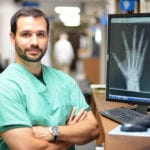
Smartphones have become an essential part of our daily lives. What many don’t know is that, while using a smartphone every day is commonplace, it can lead to a life-altering phone hand injury. In her Scientific American magazine article titled “Texting Thumb, Trigger Finger, Gamer’s Thumb and Other Smartphone Injuries,” Dr. Carolyn Barber discussed her first hand experience with an injury due to excessive use of her phone. The piece cites a familiar expert in the field of smartphone hand injuries-- Dr. Donnelly himself.
Hands weren’t made for phones
"Let’s face it: our hands weren’t really made for all of this. "Dr. Carolyn Barber
As Dr. Barber states in her article, many studies have shown the cumulative effects of smartphone use on the musculoskeletal system, with up to two thirds of mobile device users in one study having such complaints, associated with the frequency of making phone calls, texting and gaming. Another study found the highest prevalence of complaints in the upper neck, back, and wrists and hands.

One device can cause multiple injuries
Dr. Donnelly explains in his blog post “Smartphone Hand Injuries” there are a number of different injuries that can arise from frequent smartphone use. Many of these conditions are what doctors call repetitive stress injuries, or injuries that arise from the overuse of a joint. “Texting thumb,” which may be classified as a type of trigger finger, is the most common phone hand injury. In addition, the growing size of smartphones in recent years has placed users’ hands under even more stress. The amount of force needed to grip a large smartphone combined with the repetitive motion of texting and swiping places an enormous burden on the small muscles of the hands, which will frequently lead to injury.
Another condition related to smartphone overuse, called “Text claw,” is associated with finger cramping-- it has actually existed since the typewriter era, but has become more prevalent with the growing popularity of smartphones. Finally, “Cell Phone Elbow,” which is caused by prolonged bending of the elbow, is a type of cubital tunnel syndrome frequently seen in smartphone users who hold their phone in their hand for extended periods of time.
How to avoid a smartphone hand Injury
Dr. Donnelly emphasizes that while more research is required to better understand the role of handheld devices in these conditions, users can take steps to alleviate or prevent the occurrence of smartphone hand injuries. Placing your phone on a table to use it can help tremendously, as the mere act of propping up a phone with your hand can be damaging to the joints and muscles. Using hands-free methods of operating your phone can also relieve hand stress. Though it’s not what most smartphone users want to hear, limiting the amount of time spent on a smartphone and taking frequent breaks can also reduce the likelihood of developing a phone hand injury.
Think you have a smartphone hand injury?
Frequent smartphone use can cause very painful and life-altering injuries to the hands and fingers. If you think you or someone you know may have developed a phone hand injury, please contact our office today to schedule an evaluation with Dr. Donnelly.
About Dr. Brandon P. Donnelly, MD
 Dr. Brandon P. Donnelly is a board certified hand surgeon with Pontchartrain Orthopedics & Sports Medicine. Dr. Donnelly completed his hand and microsurgery fellowship at the prestigious Philadelphia Hand to Shoulder Center. Dr. Donnelly treats all ages of patients in the greater New Orleans area for hand, wrist, and elbow conditions.
Dr. Brandon P. Donnelly is a board certified hand surgeon with Pontchartrain Orthopedics & Sports Medicine. Dr. Donnelly completed his hand and microsurgery fellowship at the prestigious Philadelphia Hand to Shoulder Center. Dr. Donnelly treats all ages of patients in the greater New Orleans area for hand, wrist, and elbow conditions.
This site is not intended to and does not provide medical advice, professional diagnosis, opinion, treatment or services to you or to any other individual. Through this website and links to other websites, Brandon P. Donnelly, MD provides general information for educational purposes only. The content provided in this website and links, is not a substitute for medical care or treatment. You should not use this information in place of a consultation or the advice of your healthcare provider. Brandon P. Donnelly, MD is not liable or responsible for any advice, course of treatment, diagnosis or any other information, services or product you obtain through this site.

